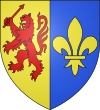
Back Labourd Afrikaans Labort AN لابورد Arabic Lapurdi AST Lapurdi Breton Lapurdi Catalan Lapurdie Czech Lapurdi Welsh Labourd German Lapurdo Esperanto
This article needs additional citations for verification. (February 2016) |
Labourd
Lapurdi | |
|---|---|
Province | |
 Location of Labourd within the Pyrénées-Atlantiques departement. | |
 Location of Labourd within the Basque Country. | |
| Country | France |
| CA | Pays Basque |
| Largest city | Bayonne (Baiona) |
| Area | |
| • Total | 859 km2 (332 sq mi) |
| Population (2013) | |
| • Total | 266,237 |
| • Density | 310/km2 (800/sq mi) |
| Time zone | UTC+1 (CET) |
| • Summer (DST) | UTC+2 (CEST) |
Labourd (French pronunciation: [labuʁ]; Basque: Lapurdi; Latin: Lapurdum; Gascon: Labord) is a former French province and part of the present-day Pyrénées Atlantiques département of Nouvelle-Aquitaine region. It is one of the traditional Basque provinces, and identified as one of the territorial component parts of the Basque Country by many, especially by the Basque nationalists.
Labourd extends from the Pyrenees to the river Adour, along the Bay of Biscay. To the south are Gipuzkoa and Navarre in Spain, to the east is Lower Navarre, and to the north are the Landes. It has an area of almost 900 km2 (347 sq mi) and a population of over 200,000 (115,154 in 1901; 209,913 in 1990), making it the most populous of the three French Basque provinces. Over 25% of the inhabitants speak Basque (17% in the Bayonne-Anglet-Biarritz zone, 43% in the rest). Labourd has also long had a Gascon-speaking tradition, notably along the banks of the river Adour but also more diffusely throughout the whole viscounty (about 20% in Bayonne-Anglet-Biarritz).
The main town of Labourd is Bayonne, although the capital up to the French Revolution was Ustaritz, 13 km away, where local Basque leaders assembled. Other important towns are Biarritz, Anglet (between Bayonne and Biarritz), Hendaye, Ciboure and Saint-Jean-de-Luz along the coast, and Hasparren inland. The area is famous for the five-day Fêtes de Bayonne and the red peppers of Espelette. Many tourists come to the coast, especially to Biarritz, and to the hills and mountains of the interior for walking and agri-tourism. La Rhune (Larrun in Basque), a 900 m high mountain, lies south of Saint-Jean-de-Luz on the border with Spain.
The traditional buildings of Labourd have low-roofed, half-timbered features, stone lintels, and red, white and green paint. The house of Edmond Rostand, Villa Arnaga at Cambo-les-Bains, is such a house and is now a museum dedicated to the author of Cyrano de Bergerac and to Basque traditions.
Lapurdian (Lapurtera) is a dialect of the Basque language spoken in the region.
© MMXXIII Rich X Search. We shall prevail. All rights reserved. Rich X Search

